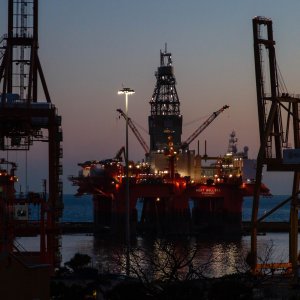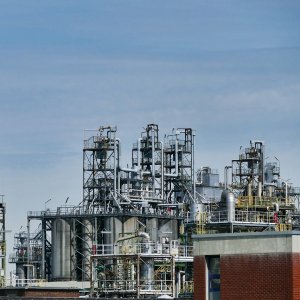
Field Profile: Lakach
When PEMEX decided to begin deepwater exploration, its first target was the Catemaco Fold Belt within the HolokTemoa asset. Early on, it focused on two hydrocarbon targets: Noxal and Lakach. Located 131km northeast of Coatzacoalcos, within the coastal waters of the Gulf of Mexico, Lakach-1 became the deepest well that PEMEX had ever drilled, at a water depth of 988m. PEMEX finally began drilling operations on the Lakach project, covering 100km2, on July 10, 2006. 131 days later, two different reservoirs had been discovered: the first anticipated to produce 25mcf/d of non-associated gas, while the second had an expected production of 30mcf/d. The discovered Miocene reservoirs containing gas and condensates were reported to hold 514.86bcf of 1P reserves as of January 2014 and total reserves of 850bcf of natural gas, assuring PEMEX of a vast supply of natural gas for the future.
PEMEX E&P’s development strategy for the project is based on a subsea-to-beach solution consisting of wet trees as subsea installations that will send the gas through two pipelines to an onshore processing plant. Lakach’s main objective is to maximize the economic value of the field’s 2P reserves by producing 650bcf of natural gas by 2023 with a projected investment of MX$20.28 billion (US$1.5 billion). Initial drilling operations include seven development wells, out of which four will be vertical and three will be directional. These wells are expected to produce from the two discovered reservoirs and are planned to be dispersed across the field’s area. Lakach-21, Lakach-32, and delineation well Lakach-2DL are expected to tap into one reservoir. The vertical well Lakach-11 and the directional wells Lakach-2, Lakach-52 and Lakach-114 are planned to access two reservoirs. Each well will have a subsea Christmas tree that will be connected to two manifolds via jumpers in order to collect the extracted hydrocarbons. The field’s production is expected to begin in early 2016 with an average rate of 400mcf/d during the first 22 months with its overall objective being to extract an accumulated 866tcf by 2025. Inland infrastructure will be comprised by Lakach’s Gas Conditioning Station, which includes a gas collection and gas recovery through monoethylene glycol processing plants. An EPC contract bid was released in October 2013 for the construction of the gas collection plant, and is expected to be awarded in May 2014. All development contracts are expected to be awarded in the shortterm after an initial contracting round failed to deliver the desired results for both PEMEX and the potential contractors. Currently, Lakach is progressing through its development stage having recently completed the Lakach-21 well, the first development well in the Mexican deepwater segment. The field is expected to hold 3.32 million barrels of proven condensate reserves, bringing its total 1P reserves up to 103.16 million boe.
PEMEX has drilled a number of exploration wells in the vicinity of the initial Lakach-1 well, including Labay, Piklis, and Kunah in Cordilleras Mexicanas and Noxal, Leek, Lalail, and Nen, which consist of Miocene plays in the Catemaco Fold Belt. When combined, these represent up to 2bcf of total natural gas reserves as well as almost 400 million boe of 3P reserves, as of January 2013. Moreover, Kunah and Piklis have already been characterized and delineated, which has proved the existence of reservoirs containing great potential for gas production. Their proximity to Lakach means that production infrastructure can be shared, lowering costs and minimizing development time.
KUNAH
Nearby the important discovery of Lakach stands Kunah, containing 1.8tcf of non-associated gas and condensate. It was found in 2012 and is located 159km northeast of Coatzacoalcos and 125km from the port of Veracruz within the Catemaco Fold Belt. As of today, two wells have already been drilled, Kunah-1 was completed in 2011, followed by the Kunah-1DL delineation well in 2012. In geologic terms, five reservoirs have been identified in an older stratigraphic horizon than the Early Miocene formations found in Lakach and Piklis. After an initial production test that reported 34mcf/d and 110b/d, it is expected to begin production by 2019.
PIKLIS
Pilklis-1 was the deepest well PEMEX had drilled at the time of its discovery. This well, located 144km northwest of Coatzacoalcos, was drilled in 1,928m of water to a total depth of 5,431m. The results of initial tests indicate the presence of between 400 and 600bcf of non-associated natural gas and condensate reserves in Early Miocene reservoirs. Most notably, Piklis-1 was the first well drilled by PEMEX with dynamic positioning equipment by the sixth-generation semisubmersible rig Centenario. The class ABS A1 semisubmersible rig, owned by Mexican company Grupo R and designed by Friede & Goldman, was leased to PEMEX for a period of five years. Additional exploration activities in the Piklis-1 area are intended to investigate a deep structure parallel to the Lakach Field.
YOKA
A recent gas discovery in the vicinity of Lakach constituted a surprising achievement for PEMEX. Yoka-1 was drilled at a depth of approximately 2,090m in early 2014, northeast of Kunah-1. The team of specialists for Yoka-1 managed to save 15 days of operational time through drilling a sidetrack with magnetic interference. Southeast of Lakach-1, this area is dominated by salt tectonics, similar to the neighboring fields in Holok and Temoa, which may represent sub-salt plays needing to be delimited.
















